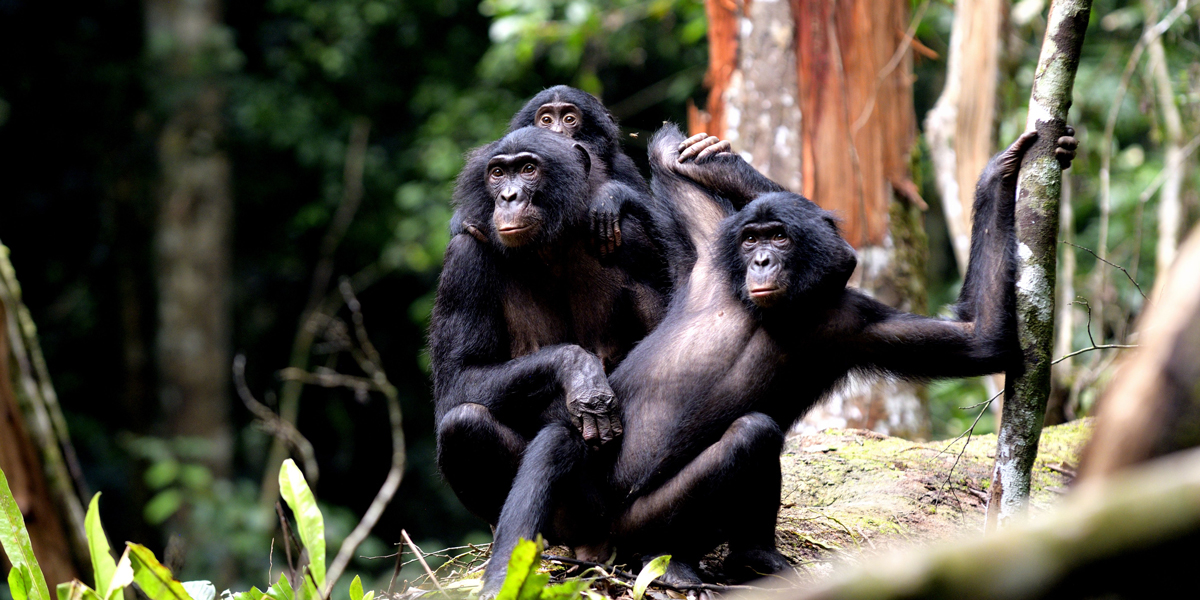
In the early morning darkness, fighting erupts in the dense rainforest canopy at the Kokolopori Bonobo Reserve. The bonobos have barely awoken when the males begin chasing one another from their nests: biting, pushing, and screaming. “I was looking at them and thinking, where’s the peaceful bonobo in all this,” says Maud Mouginot, a biological anthropologist who recently completed her doctorate with College of Biological Sciences Professor Michael Wilson. “They are not playing,” she says, noting that the action often continued throughout the day.
In new research published in Current Biology, Mouginot, Wilson, and colleagues change the script about bonobos, which have long been heralded as the docile, free-love cousins of chimpanzees. The research was based on more than 9,000 hours of close field observation of bonobos (in the Democratic Republic of the Congo) and chimpanzees (in Tanzania). The researchers trailed individual males from sunrise to sunset, using binoculars and sidestepping branches that plummeted from the overhead scuffles. They then compared rates of aggression between the species. Contrary to expectations, physical aggression among males was three times more common for bonobos than chimpanzees, even though bonobos have never been observed using lethal force toward one another.
The findings challenge a popular hypothesis positing that bonobos underwent a self-domestication process, whereby less aggressive individuals were more successful, resulting in a more pacifistic society. If this were the case, Mouginot and other field researchers should have observed that friendlier males were more desirable to females. Instead, they found the opposite was true. Aggressive bonobo males were more likely than their friendlier counterparts to mate with females in the crucial ovulation window, suggesting that aggression is not only normal but also reproductively beneficial.
Nonetheless, the researchers documented a scenario where male bonobo aggression was lower than chimpanzees: they were less likely to act aggressively toward females. In fact, it’s more common for female bonobos to engage aggressively toward males than the other way around. The differences may point to the significance of the female-dominated hierarchy for bonobos, which could make aggression among males less consequential than aggression directed toward females. The opposite social hierarchy occurs with chimpanzees, and males commonly form coalitions to defend their territory, rendering violence among allied males more costly. Still, Wilson points out that the findings weren’t clear-cut. “Bonobo males were still aggressive towards females,” he says, “It occurred less often, but the rates were intermixed with the rates for male chimpanzees, rather than all male chimpanzees being more aggressive towards females.”
Overall, the researchers revealed the previously unquantified role of aggression among bonobos, complicating a related storyline proposed for human evolution. If bonobos underwent self-domestication, the idea goes, the same might be true for humans, given that bonobos and chimpanzees are the closest living relatives of humans. While the new research doesn’t invalidate the self-domestication hypothesis for humans, it suggests the parallel with bonobos may have been too simple.
“I think we’re really lucky to have both bonobos and chimpanzees,” says Wilson, pointing out that if only one of the species existed, it would be tempting for researchers to draw easy assumptions about how humans evolved from our nearest relatives. If humans and chimpanzees shared a particular trait, and bonobos—an endangered species with a range threatened by deforestation—didn’t exist, someone might jump to the conclusion that our last common ancestor shared the same characteristic. “In reality, our ancestor was probably really different from bonobos or chimpanzees or humans,” Wilson says. — Jonathan Damery